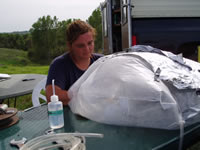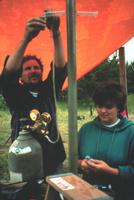|
A unifying theme of USGS Toxic Substances Hydrology Program investigations is
the characterization of the natural response of hydrologic systems to contamination. This makes the sites where
the investigations are conducted ideally suited to assessing potential long-term impacts, evaluating the
potential and the limitations of remediation by monitored natural
attenuation, and designing systems to monitor the performance of remediation where monitored natural
attenuation is being relied upon. The information presented on this page cuts across lines drawn by individual
investigations and projects so that information on the natural attenuation of contaminants can be presented in
one place.
Investigations and Research Activities
- Investigations
- Natural Attenuation Remediation-Related Activities

USGS scientists installing diffusion samplers
and microcosms to study subsurface bacteria that degrade trichloroethylene
at the Naval Air Warfare Center
Research Site, West Trenton, NJ (circa 2005). The samplers will
help USGS and U.S. Navy scientists evaluate the performance of a
biostimulation and bioaugmentation experiment.
(Click on Image for a Larger Version)
Fact Sheets

USGS scientists assisted the U.S. Navy with the
design and assessment of an innovative remediation system that involved
the injection of
an oxygen-release compound in the source area of a chlorobenzene
and benzene plume at the Naval Air Station, Pensacola, Florida.
The two transects are along ground-water flow paths
(Click on Image for a Larger Version)

Collecting ground-water samples anaerobically in a glove bag as part of a study of the
biogeochemistry of a landfill leachate plume at the Norman Landfill Research
Site, OK. The glove bag helps preserve sensitive redox species so an accurate determination of the processes
that control the natural attenuation of the leachate can be made
(Click on Image for a Larger Version)
|

Collecting pore water from cores to identify natural attenuation processes in ground water
at the Bemidji Crude Oil Spill Site, MN. The scientists are withdrawing
water with a syringe from a core encased in polycarbonate tubing. The bottom of the core was
frozen to prevent fluid from escaping the core. This technique allows
for closely spaced samples that enable scientists to study the biogeochemical heterogeneity of contaminant
plumes
(Click on Image for a Larger Version)
Headlines
Bibliography
New Publications
Upcoming Publications
- Subsurface fate and transport of 4-nonylphenol, 17Β-estradiol, and sulfamethoxazole: Barber, L.B., Meyer, M.T., LeBlanc, D.R., Kolpin, D.W., Bradley, P.M., Chapelle, F.H., and Rubio, F., in Hill, M.C., ed., Groundwater Quality 2007--Securing Groundwater Quality in Urban and Industrial Environments: International Association of Hydrological Sciences IAHS Redbook (IN PRESS).
- Biological degradation of chloroethenes: Bradley, P.M., and Chapelle, F.H., in SERDP/ESTCP Monograph on Remediation of Dissolved-Phase Chlorinated Solvents: (IN PRESS).
- Biochemical indicators for the bioavailability of natural dissolved organic carbon in ground water: Chapelle, F.H., Bradley, P.M., Goode, D.J., Tiedeman, C., Lacombe, P.J., Kaiser, K., and Benner, R., Ground Water (IN PRESS).
Newly Published
- Arsenic(III) fuels anoxygenic photosynthesis in hot spring biofilms from Mono Lake, California: Kulp, T.R., Hoeft, S.E., Asao, M., Madigan, M.T., Hollibaugh, J.T., Fisher, J.C., Stolz, J.F., Culbertson, C.W., Miller, L.G., and Oremland, R.S., 2008, Science, v. 321, no. 5891, p. 967-970, doi:10.1126/science.1160799.
- Coupled effect of chemotaxis and growth on microbial distributions in organic-amended aquifer sediments--Observations from laboratory and field studies: Wang, M., Ford, R.M., and Harvey, R.W., 2008, doi:10.1021/es702392h (Advanced Web release).
- Coupled effect of chemotaxis and growth on microbial distributions in organic-amended aquifer sediments--Observations from laboratory and field studies: Wang, M., Ford, R.M., and Harvey, R.W., 2008, doi:10.1021/es702392h (Advanced Web release).
- Redox processes and water quality of selected principal aquifer systems: McMahon, P.B., and Chapelle, F.H., 2008, Ground Water, v. 46, no. 2, p. 259-271, doi:10.1111/j.1745-6584.2007.00385.x.
- Anoxic mineralization--Environmental reality or experimental artifact?: Bradley, P.M., Chapelle, F.H., and Löffler, F.E., 2008, Ground Water Monitoring and Remediation, v. 28, no. 1, p. 47-49, doi:10.1111/j.1745-6592.2007.00186.x.
- Determination of dominant biogeochemical processes in a contaminated aquifer-wetland system using multivariate statistical analysis: Báez-Cazull, S.E., McGuire, J.T., Cozzarelli, I.M., and Voytek, M.A., 2008, Journal of Environmental Quality, v. 37, no. 1, p. 30-46, doi:10.2134/jeq2007.0169.
- Effects of ionic strength, temperature, and pH on degradation of selected antibiotics: Loftin, K.A., Adams, C.D., and Meyer, M.T., 2008, Journal of Environmental Quality, v. 37, no. 2, p. 378-386, doi:10.2134/jeq2007.0230.
- Potential for 4-n-nonylphenol biodegradation in stream sediments: Bradley, P.M., Barber, L.B., Kolpin, D.W., McMahon, P.B., and Chapelle, F.H., 2008, Environmental Toxicology and Chemistry, v. 27, p. 260-265, doi:10.1897/07-333.
- Bioaccumulation of pharmaceuticals and other anthropogenic waste indicators in earthworms from agricultural soil amended with biosolid or swine manure: Kinney, C.A., Furlong, E.T., Kolpin, D.W., Burkhardt, M.R., Zaugg, S.D., Werner, S.L., Bossio, J.P., and Benotti, M.J., 2008, Environmental Science and Technology, doi:10.1021/es702304c (Advanced Web release).
- Biodegradation in contaminated aquifers--Incorporating microbial/molecular methods: Weiss, J.V., and Cozzarelli, I.M., 2008, Ground Water, doi:10.1111/j.1745-6584.2007.00409.x (Advanced web release).
Meetings and Conferences

USGS scientist collecting an unsaturated-zone gas sample with a syringe from a vapor
sampling well at the Bemidji Crude Oil Spill Research Site, Bemidji, MN.
The sample was used to study the natural attenuation of hydrocarbon vapors in the unsaturated zone.
(Click on Image for a Larger Version)
|